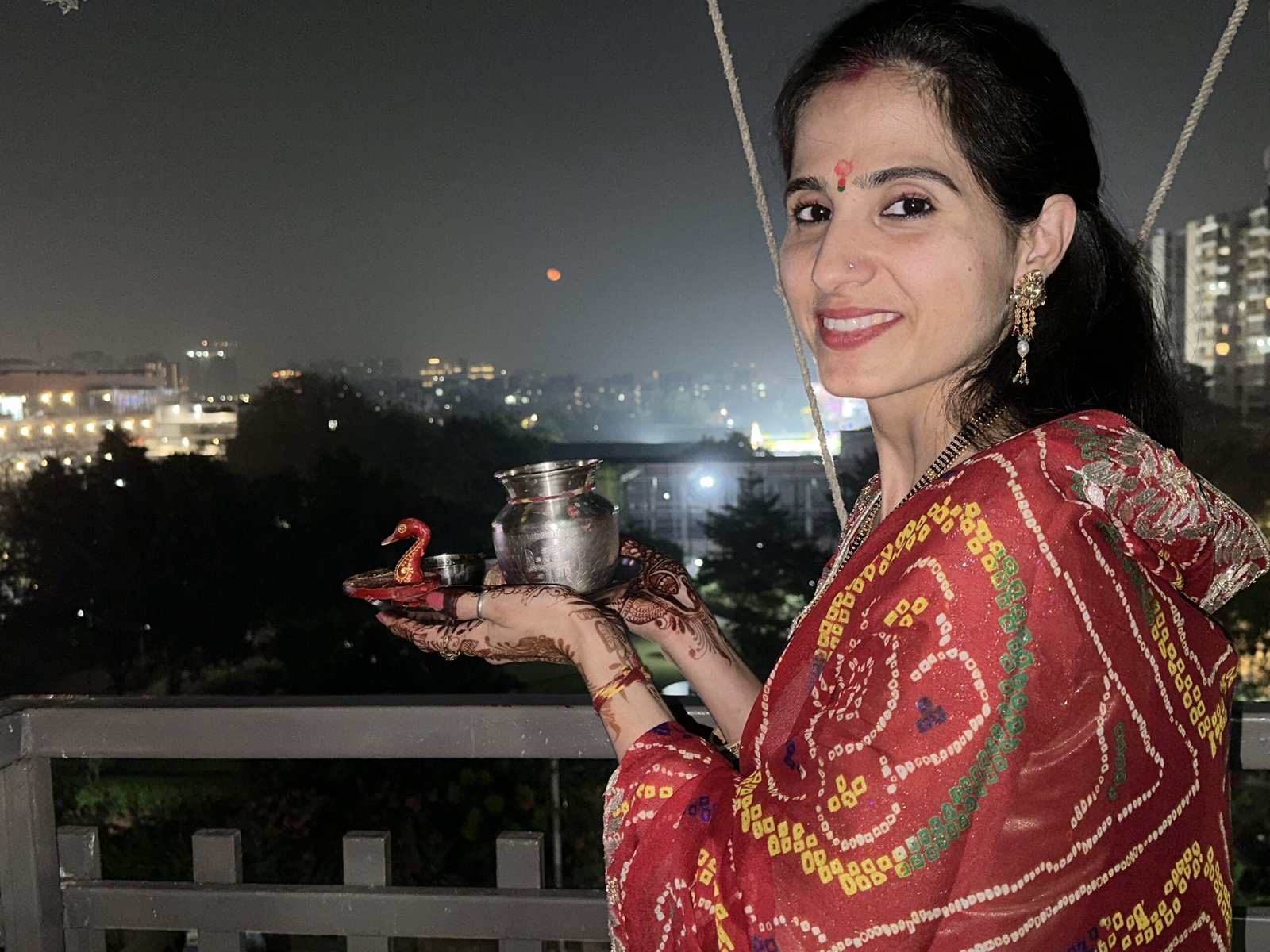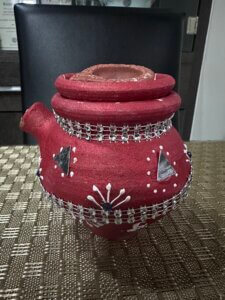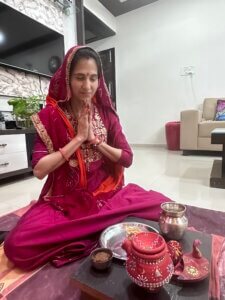
Reading Time: 5 minutes
Karva Chauth: Celebration of Love and Togetherness in Sanatam Tradition. Karva Chauth, a prominent and revered Hindu festival, is a manifestation of deep love and devotion shared between married couples.
In this article, we explore the historical origins, significance, and customs associated with this remarkable celebration.
History of Karva Chauth:
Karva Chauth finds its roots in ancient legends and mythology. The term “Karva Chauth” originates from two words: “Karva,” meaning an earthen pot used for storing wheat, and “Chauth,” signifying the fourth day.

The festival has its roots in the Mahabharata era when Draupadi observed a similar fast for the well-being of her beloved husbands.
Ancient Beginnings:
The history of Karva Chauth can be traced back to ancient India. It is a testament to the customs and traditions that have persisted through generations. The word “Karva” means an earthen pot, and “Chauth” refers to the fourth day. This festival falls on the fourth day of the Kartik month, which is the beginning of the harvest season.
Draupadi and the Mahabharata Connection:
One of the most popular legends associated with Karva Chauth is the story of Draupadi, a central character in the Mahabharata. Legend has it that Draupadi observed a fast for the well-being of her beloved husbands, the Pandavas. Her unwavering devotion and perseverance while fasting had a profound impact on the Hindu tradition. Her story serves as an inspiration for countless women who fast on this day.
The Connection with Lord Shiva and Parvati:
Another story that adds to the historical significance of Karva Chauth is the tale of Lord Shiva and Parvati. It is believed that on this day, Goddess Parvati was narrating the significance and rituals of Karva Chauth fasting to Lord Shiva. A peeping servant overheard this conversation and unintentionally revealed the secrets to his queen. It is said that this is why married women traditionally observe the fast while praying for the well-being of their husbands.
Different Names of Karva Chauth:
Karva Chauth is celebrated across India under various regional names.
In Punjab, it is “Karva Chauth,” but it may be known as “Vrat ki Chauth” or “Satyanarayan Ki Chauth” in other regions.
Regardless of the name, the festival underscores the importance of love and marital bonds
Karva Chauth in Different Regions:
The historical significance of Karva Chauth transcends regions and cultures. While it is most popular in North India, it is celebrated in various forms across the country.
Each region brings its own unique customs and rituals to the celebration, making it a diverse and culturally rich festival.
Revival and Modern Celebration:
In recent times, Karva Chauth has witnessed a revival and resurgence in popularity.
The modern celebration often includes exchanging gifts, applying intricate mehndi designs, and dressing in traditional attire.
It has found a place in popular culture, with Bollywood films showcasing the festival’s significance.
Date of Celebration:
Karva Chauth is celebrated on the fourth day after the full moon in the month of Kartik (typically in October or November). This festival comes after Dasera festival.
This fasting tradition starts at sunrise and continues until moonrise. Women fast as an act of devotion and care for their husbands.
Celebration of Karva Chauth:
Karva Chauth is observed with extensive rituals and preparations:
- Day-Long Fast: Married women fast from sunrise to moonrise, expressing their unwavering devotion to their spouses.
- Mehndi Application: Intricate henna designs are applied on women’s hands and feet, often featuring motifs like the moon, stars, and decorative patterns.
- Elegance in Attire: Women dress in their finest traditional clothing and jewelry, making the day a memorable one.
- Pre-Fast Meal (Sargi): Mothers-in-law provide a pre-fast meal called “sargi” before sunrise. This meal typically includes sweets, fruits, and savories to keep them energized throughout the day.
- Evening Puja: In the evening, women gather with other fasting women to perform a puja (ritual). The puja involves prayers and blessings for the health and longevity of their husbands.

The Rituals of Karva Chauth
The rituals of Karva Chauth are steeped in tradition, involving several steps that create a spiritually enriching experience for women.
1. Sargi: The day begins with a pre-dawn meal called “Sargi,” which is prepared by the mother-in-law for the fasting woman. Sargi includes various food items, sweets, dry fruits, and coconut water to provide energy and hydration for the day-long fast.
2. Nirjala Fast: One of the unique aspects of Karva Chauth is that it is a “Nirjala” fast, meaning women do not consume even a drop of water throughout the day. This fast is considered one of the most difficult but highly rewarding rituals, as it signifies a woman’s love and dedication towards her husband.
3. Pooja and Prayer: In the evening, women dress up in traditional attire, often wearing red or other bright colors symbolizing happiness and prosperity. They gather with other married women in the community to perform the “Karva Chauth pooja,” where they listen to the “Karva Chauth Katha” (story). The pooja thali (plate) is decorated with a diya (lamp), flowers, sindoor (vermilion), and sweets.
4. Chanting and Mantras: The women chant traditional mantras and sing folk songs as part of the ritual. They pray to Goddess Parvati for the well-being and longevity of their husbands, seeking her blessings for a happy and fulfilling married life.
5. Moonrise and Breaking the Fast: The most awaited moment of the day is the moonrise. Women break their fast only after sighting the moon. They view the moon through a sieve, and then look at their husband through the same sieve, symbolizing the filtering of all negativity and evil from their lives. The husband then offers the first sip of water to his wife, breaking her fast, followed by feeding her the first bite of food.
The Cultural and Emotional Significance
Karva Chauth is not just a ritual; it’s a celebration of the sacred bond between a husband and wife. It represents a woman’s love, sacrifice, and prayers for her husband’s safety and prosperity. Over the years, the festival has evolved to also emphasize the husband’s role in appreciating and supporting his wife’s dedication, making it a mutual celebration of love.
In modern times, Karva Chauth has gained popularity not just in India but also among Indian communities abroad. The festival has become a symbol of marital devotion, with many husbands observing the fast alongside their wives, making it a gesture of equality and shared love.
Conclusion:
Karva Chauth: Celebration of Love and Togetherness in Sanatam Tradition. Karva Chauth stands as a symbol of love, devotion, and the enduring bond between spouses.
The rich history of this festival, rooted in ancient traditions and legends, continues to be celebrated with zeal and enthusiasm by married women across India.

